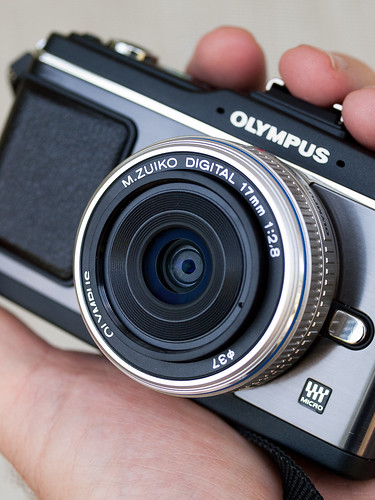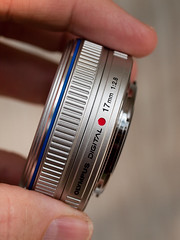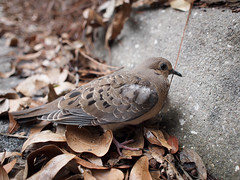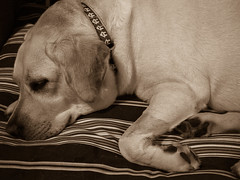Concept: 4 out of 5
Execution: 3 out of 5
Yeah, but: Inexpensive and a blast to use.
The Long Version: If you're a reader of this blog you've no doubt read Matthew's earlier review of the Panasonic Lumix G 20mm F/1.7 ASPH. Matthew described the 20mm as "perhaps the single best lens available for micro four-thirds cameras." There's no denying that at a maximum aperture of f/2.8, the Olympus pancake is a good stop-and-a-half slower than the 20mm at f/1.7. And coupled with the GH1, the combination is, again quoting Matthew, "a dominant force in the mirrorless market segment." High praise indeed.
I'm not here to counter points that Matthew makes in his review. It's in bad form (I am, after all, an invited guest blogger) and it's pointless. The 17mm is matched for the Olympus Pen series (currently the E-P1, E-P2, and E-PL1) in much the same fashion that the 20mm is matched to the Panasonic line of micro four-thirds cameras. Both the 20mm and 17mm, measurebation and specifications notwithstanding, are for all practical purposes equally capable instruments when used competently.
The 17mm, like it's Panasonic cousin, is a minor marvel of engineering. At 57mm diameter by 22mm length, and weighing a rather wispy 71g, it's almost too small to comfortably hold. When it's mounted on one of the Olympus digital Pens, the combination fits comfortably in the palm of my hand, and is small enough to easily slip into a jacket, coat, or (if you're wearing cargo pants or shorts) small enough to fit into a large pants pocket. Its equivalent 35mm focal length is 34mm; in days of yore when I shot film with primes, the 35mm lens was my favorite focal length, allowing me to include more of the world in my photographs without the undue distortion of wider angle lenses such as the 28mm or 24mm. In its own way purchasing the 17mm was like coming home again.
The 17mm is constructed primarily of plastics (or "composites" as they're called in some quarters), which includes the focusing ring, outer lens body, and front facing elements (but not the front lens). The mount is well-machined and chromed metal; it mounts smoothly and tightly on my E-P2, with no play or wiggle once mounted. The plastics used in the lens are of excellent quality, with crisp molding across the entire lens. In spite of the extensive use of plastics (or perhaps because of it) the feeling of the 17mm is one of quality and precision, in keeping with the E-P2 body.
With the latest firmware available for the digital Pens, the 17mm is quick and accurate to automatically focus on just about any subject, or in my case, on every subject I've taken with the lens to date. The only problem regarding autofocus with the 17mm is the same problem you'll find with the M.Zuiko 14-42mm kit lens; autofocus noise. For stills it's not an issue. For video it's noisy enough to be heard on the audio track. I'm certainly no expert on video photography; when I use the E-P2 and 17mm for video, I don't use continuous autofocus, prefering instead to compose, then let the camera single focus on the subject, then record. Nothing annoys me more than to see a camera hunt for focus lock on a video. And if you must have silent continuous autofocus, then Olympus has two new silent focusing micro four-thirds lenses for you to choose from; the M.Zuiko Digital ED 14-150mm f4.0-5.6 tele-zoom and the M.Zuiko Digital ED 9-18mm f4.0-5.6 UWA zoom.
The E-P2 and the 17mm combine to create an almost sublime picture taking machine, a device that melts into the hand, that's so small and unobtrusive that it gives a sense of intimacy with the world that is almost impossible to achieve with a regular DSLR such as the Olympus E-3 or its many similar kindred. Big cameras enslave you to a particular regimen with regards to photography; put the camera up to the eye in front of your face, between you and the world, spend critical moments manipulating the camera, then record the image. With the E-P2 and 17mm, I can hold the camera away from me, then use live view out of the corner of one eye to judge basic composition while keeping the majority of my attention on the world in front of me. The injured pigeon above was taken with my hand and the E-P2 less than a foot away, in my hand, while I kept the rest of my body away from the bird in order to minimize spooking it.
And sometimes its good to be able to hold the camera away from the body; while attempting to photograph the hawk, I held the E-P2 in front and above the subject while I kept a weather eye on the multiple lanes of traffic that kept passing by me at every green light.
When I purchased the E-P2 in December of 2009, I purchase it in a kit that included the 14-42mm kit zoom and the VF-2 electronic viewfinder. For a time, I used the VF-2 almost religiously, aping my SLR/DSLR technique of holding the camera in front of my face. The 17mm has broken me of that habit, allowing me to continually approach a subject unobtrusively, seeking the best point of view without looking like a hunched over idiot and drawing attention to myself. With the 17mm on the E-P2, I can quietly and quickly take those special moments without physically intruding and thus disturbing the moment I'm trying to capture.
So is the 17mm good enough to invest in? Absolutely. Although it isn't cheap, it's cost is much less than the 20mm, allowing you an easier entrée into a whole different technique of photography, allowing easy and experimental perspectives for photographing the world around you, a way to more closely inspect the world around you. Both pancake lenses are superb, and will reward the user when used properly. Which one you choose comes down to purely a matter of personal taste and/or budget.
2010-07-17
Subscribe to:
Post Comments (Atom)
contact me...
You can click here for Matthew's e-mail address.












It's sad how so many people have gone ga-ga over the Panasonic 20mm, and giving the Oly 17mm scant attention. But if I were to own an Oly Pen camera, I would certainly want that lens for it, if only because Pens & pancakes seem to be a match made in heaven, and the 17mm focal length is probably the closest to ideal for general purpose photography.
ReplyDeleteBut I do wish both Panasonic and Olympus would come out with a 25mm pancake as well. I've heard the Olympus regular 4/3 pancake works will with the Pen cameras, but still, it would be nice to have something native for that mount.
I believe Olympus will soon have a 12mm pancake available to complement this lens, as well as a 50mm macro native to micro 4/3. With just those three lenses, you can do quite a bit of photography in a very small, light-weight kit.
This is small lens. That's its main claim to fame, not the speed at f2.8, nor the focal length, the equivalent of about 35mm in 35mm photography. But on the small Olympus PEN body, this lens gives you a small package that takes quite good pictures without messing around with a zoom. In particular, it works well as a walking-around street camera, much like an old Leica or a Canon rangefinder of the 1950s/1960s. (See also the optical viewfinder which has image lines specifically for this 17mm lens.)
ReplyDelete